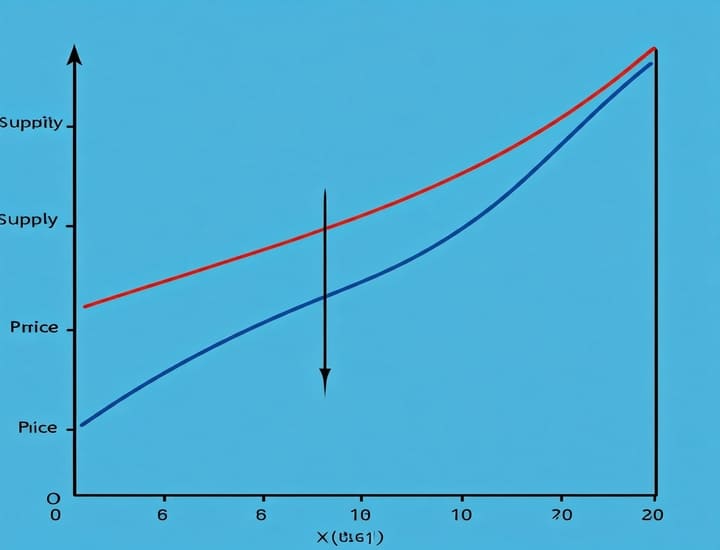We often hear about supply and demand when markets, prices, and supply are discussed. Equilibrium is simply the balance between supply and demand. It is when what people want matches what is available. However, when prices move away from this balance, excess supply can be increased. This happens when producers make more goods than people want to buy at a given price. When excess supply is created when price or move away from the equilibrium point, many things can happen, and it is important to understand these changes.
Understanding Equilibrium in a Market
The equilibrium price is the point where supply meets demand. This price ensures that everyone who wants to buy a product at that price can do so. At the same time, producers sell all the goods they have made. In this ideal situation, there is no excess supply or shortage.
But what happens if the price changes? Imagine the price going higher than the equilibrium point. This is where problems can begin. At a higher price, fewer people want to buy the product. As a result, sellers are left with more goods than they can sell. Excess supply is created when price or move away from the equilibrium point.
Causes of Excess Supply
One main cause of excess supply is a rise in prices. When prices are too high, demand falls. People are not willing to pay for goods at that price. At the same time, producers may still be making the same amount of goods. The result is too much supply and not enough demand.
Another reason can be poor planning by businesses. Sometimes, companies expect higher demand than what happens. They may produce more goods than the market can handle. In these cases, excess supply is created when price or move away from the equilibrium point.
In some cases, external factors like technological changes or government policies can also affect supply. New technologies might allow companies to produce more goods at a lower cost. If demand does not grow at the same pace, this can also lead to excess supply.
Effects of Excess Supply
When excess supply occurs, it can cause several problems for businesses and the economy. First, companies may lower their prices to sell off the extra goods. This price drop can hurt profits and make it harder for businesses to survive.
Second, when excess supply is created when price or move away from the equilibrium point, it can lead to waste. Unsold goods may go unused or become outdated. In industries like food or fashion, this waste can be significant.
Moreover, excess supply can signal to businesses that they need to reduce production. This means fewer jobs for workers, as companies may cut back on staff to match lower demand.
Solutions to Excess Supply
To solve the problem of excess supply, companies can try several strategies. One approach is to adjust their production levels. By reducing the number of goods they make, businesses can avoid having too much stock that they cannot sell.
Another strategy is to adjust prices. By lowering prices, companies can attract more buyers. This can help bring the market closer to equilibrium. In this way, excess supply is created when price or move away from the equilibrium point, but it can be reduced through smarter pricing decisions.
Sometimes, businesses may try to expand to new markets. If demand is low in one region, they may find new customers elsewhere. This can help to balance supply and demand.
Government intervention can also play a role in addressing excess supply. For example, subsidies or financial aid can help industries that produce more than what the market needs. In the long term, though, businesses must adjust to avoid future oversupply.
The Importance of Market Signals
Market signals play a key role in avoiding excess supply. Prices act as a signal for both buyers and sellers. When prices rise, it tells sellers to produce more. However, if prices rise too much, it can lead to excess supply. When excess supply is created when price or move away from the equilibrium point, it is often because sellers do not respond quickly to market signals.
On the other hand, when prices fall, it signals that there may be too much supply. Sellers can reduce their output to prevent a further drop in prices. Businesses need to monitor these signals and adjust their actions to maintain balance.
Global Markets and Excess Supply
In today’s global economy, an excessive amount of supply might more easily be constructed. For example, after producing too much steel, if a country lowers the price of its steel and pushes the lower prices into other countries, it creates some challenges since those countries’ industries might not be able to compete with the adjusted price of steel in their own markets.
An excess amount of supply becomes constructed when prices move away from or into equilibrium, and on a larger scale the supply moves away from equilibrium, then trade imbalances could occur if more than one country engages in similar actions. Countries who feel like their industries are at risk of being overwhelmed by the cheaper imported goods, could enforce or invoke tariffs and restrictions so they do not overpopulate their own markets with cheap goods.
To mitigate the above, collaboration among countries and trading partners could help. Trade agreements could stop excessive excess supplies from interfering with global pressures on the markets. Trade agreements could apply limits on the quantity of substitutes exported so that the markets could maintain equilibrium.
The Role of Technology in Managing Supply
Technology has afforded businesses to exercise more control over their supply and manage the risk of overproduction. For example, data analytics can provide a company with the tools necessary to better predict demand. When GOOD businesses use data, they can respond to the consumer to decrease the amount of safer stock they would keep in numbers.
Additionally, automation allows companies to scale production up or down quickly. This flexibility can be useful when trying to avoid excess supply. When excess supply is created when price or move away from the equilibrium point, technology can offer solutions that were not available in the past.
Consumer Behavior and Excess Supply
Consumer behavior also plays a role in excess supply. If people suddenly change their buying habits, businesses may be caught off guard. For example, a shift in trends or preferences can leave companies with unsold products.
Businesses need to stay in touch with consumer preferences. Surveys, market research, and social media monitoring can all provide valuable insights into what people want. When excess supply is created when price move away from the equilibrium point, it may be because companies fail to anticipate these changes in consumer demand.
Conclusion
In conclusion, excess supply happens when prices move away from the equilibrium point. When prices are too high, fewer people buy products, leading to a surplus of goods. This can cause problems like waste, lower profits, and job losses. However, businesses can take steps to manage this issue. By adjusting prices, cutting production, and paying attention to market signals, they can keep supply and demand in balance.
Understanding that excess supply is created when price or move away from the equilibrium point helps both businesses and consumers. It is a key concept in maintaining a healthy economy where goods are produced and consumed efficiently.
FAQs Navigating Common Queries
1. What is excess supply?
- Excess supply occurs when the quantity of goods produced is greater than the quantity demanded by consumers at a given price. This often happens when prices rise above the equilibrium point, reducing demand.
2. How is excess supply created when price or move away from the equilibrium point?
- Excess supply is created when price or move away from the equilibrium point because higher prices discourage buyers from purchasing products. As a result, sellers are left with unsold goods, creating a surplus.
3. What is the equilibrium point in a market?
- The equilibrium point is where the quantity of goods supplied equals the quantity demanded. At this price, the market is balanced, with no excess supply or shortage.
4. What are the causes of excess supply?
- Excess supply is caused by high prices, poor production planning, external factors like government policies, or new technology that increases production without a corresponding rise in demand.
5. How can businesses solve the problem of excess supply?
- Businesses can solve excess supply by lowering prices, reducing production, finding new markets, or improving planning with data-driven strategies to avoid overproduction.

